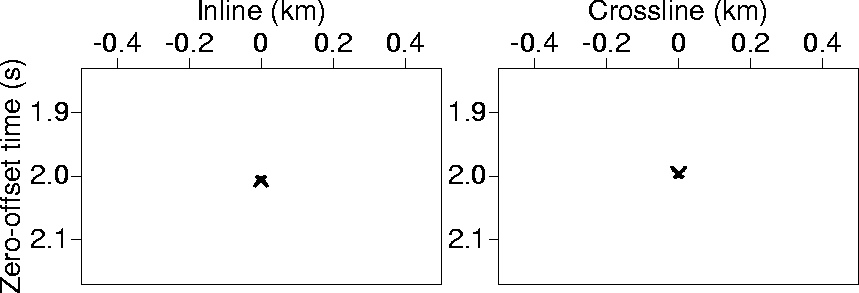|
AMO1eta1res
Figure 12 A side view of a residual AMO operator responsible for the correction from a VTI model to an isotropic one for a pure azimuth correction of 30 degrees. The anisotropy model considered here has |  |
The residual AMO operator includes a cascade of two AMO operators corresponding to the same correction, but opposite sign, in offset and azimuth, but with different media parameters. Equivalently, it includes four 3-D v(z) DMO operations; two forward operations and two inverse ones. The difference between each of the pair of forward and inverse operations is the medium parameters. In this case, a pair of forward and inverse DMO's, or AMO, is applied for an isotropic medium followed by another pair corresponding to a VTI medium.
The size of the residual AMO operator is directly dependent on the amount of medium perturbation from the isotropic background model. The residual operator provides information on the impact that the perturbation in anisotropy has on the AMO operator. The smaller the size of the residual operator, the lesser the anisotropy has influenced the AMO operator, and thus the lesser the need to use it.
Figure 12 shows the residual AMO operator that corrects an isotropic AMO operator to a VTI AMO one. In other words, this residual AMO operator, when convolved with the isotropic-medium AMO operator, provides us with the VTI AMO operator. The AMO operators involved correspond to a pure azimuth correction of 30 degrees. The resulting residual operator is, as expected, smaller than the corresponding full AMO operator shown in Figure 5. The shape of the operator is rather complicated with triplications at low angles.
|
AMO1eta1res
Figure 12 A side view of a residual AMO operator responsible for the correction from a VTI model to an isotropic one for a pure azimuth correction of 30 degrees. The anisotropy model considered here has |  |
A better view of the operator in Figure 12 can be obtained by displaying the inline and crossline components of the residual AMO operator, separately. Figure 13 shows such a display, which confirms the low angle nature of the triplication and the small size of the operator. Thus the differences in the AMO operator for homogeneous and VTI media starts at a considerably low angle.
 |